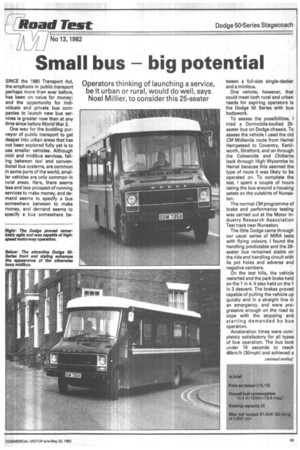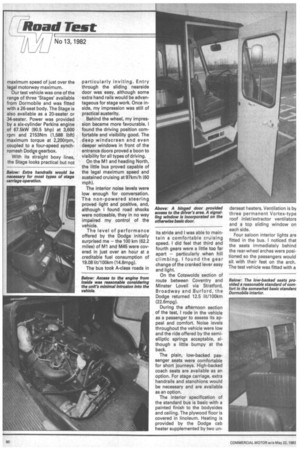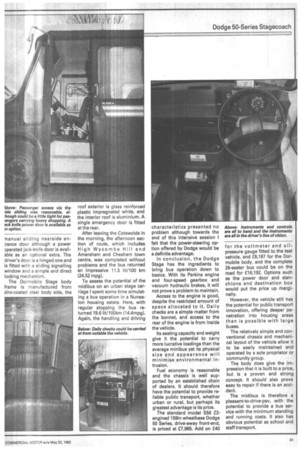Small bus big potential
Page 51

Page 52

Page 53

If you've noticed an error in this article please click here to report it so we can fix it.
Operators thinking of launching a service, be it urban or rural, would do well, says Noel Millier, to consider this 25-seater
SINCE the 1980 Transport Act, the emphasis in public transport perhaps more than ever before, has been on value for money; and the opportunity for individuals and private bus companies to launch new bus services is greater now than at any time since before World War 2.
One way for the budding purveyor of public transport to get deeper into urban areas that has not been explored fully yet is to use smaller vehicles. Although mini and midibus services, falling between taxi and conventional bus systems, are common in some parts of the world, smaller vehicles are only common in rural areas. Here, there seems less and less prospect of running services to make money, and demand seems to specify a bus somewhere between to make money, and demand seems to specify a bus somewhere be tween a full-size single-decker and a minibus.
One vehicle, however, that could meet both rural and urban needs for aspiring operators is the Dodge 50 Series with bus bodywork.
To assess the possibilities, I tried a Dormobile-bodied 25seater bus on Dodge chassis. To assess the vehicle I used the old CM Midlands route from Hemel Hempstead to Coventry, Kenilworth, Stratford, and on through the Cotswolds and Chilterns back through High Wycombe to Hemel because this seemed the type of route it was likely to be operated on. To complete the test, I spent a couple of hours taking the bus around a housing estate on the outskirts of Nuneaton.
The normal CM programme of brake and performance testing was carried out at the Motor Industry Research Association Test track near Nuneaton.
The little Dodge came through our usual series of MIRA tests with flying colours. I found the handling predictable and the 26seater bus remained stable on the ride and handling circuit with its pot holes and adverse and negative cambers.
On the test hills, the vehicle restarted and the park brake held on the 1 in 4. It also held on the 1 in 3 descent. The brakes proved capable of pulling the vehicle up quickly and in a straight line in an emergency, and were progressive enough on the road to cope with the stopping and starting demanded by bus operation.
Acceleration times were completely satisfactory for all types of bus operation. The bus took under 16 seconds to reach 48km/h (30mph) and achieved a maximum speed of just over the legal motorway maximum.
Our test vehicle was one of the range of three 'Stages' available from Dormobile and was fitted with a 26-seat body. The Stage is also available as a 20-seater or 34-seater. Power was provided by a six-cylinder Perkins engine of 67.5kW (90.5 bhp) at 3,600 rpm and 2153Nm (1,588 lbft) maximum torque at 2,200rpm, coupled to a four-speed synchromesh Dodge g_earbox.
With its straight boxy lines, the Stage looks practical but not particularly inviting. Entry through the sliding nearside door was easy, although some extra hand rails would be advantageous for stage work. Once inside, my impression was still of practical austerity.
Behind the wheel, my impression became more favourable. I found the driving position comfortable and visibility good. The deep windscreen and even deeper windows in front of the entrance doors proved a boon to visibility for all types of driving.
On the M1 and heading North, the little bus proved capable of the legal maximum speed and sustained cruising at 97km/h (60 mph).
The interior noise levels were low enough for conversation. The non-powered steering proved light and positive, and, although I found road shocks were noticeable, they in no way impaired my control of the vehicle.
The level of performance offered by the Dodge initially surprised me — the 100 km (62.2 miles) of Ml and M45 were covered in just over an hour at a creditable fuel consumption of 19.08 lit/100km (14.8mpg).
The bus took A-class roads in its stride and I was able to maintain a comfortable cruising speed. I did feel that third and fourth gears were a little too far apart — particularly when hill climbing. I found the gear change of the cranked lever easy and light.
On the Cotswolds section of route between Coventry and Minster Lovell via Stratford, Broadway and Burford, the Dodge returned 12.5 lit/100km (22.6mpg).
During the afternoon section of the test, I rode in the vehicle as a passenger to assess its appeal and comfort. Noise levels throughout the vehicle were low and the ride offered by the semielliptic springs acceptable, although a little bumpy at the back.
The plain, low-backed passenger seats were comfortable for short journeys. High-backed coach seats are available as an option. For stage carriage, extra handrails and stanchions would be necessary and are available as an option.
The interior specification of the standard bus is basic with a painted finish to the bodysides and ceiling. The plywood floor is covered in linoleum. Heating is provided by the Dodge cab heater supplemented by two un
derseat heaters. Ventilation is by three permanent Vortex-type roof inlet/extractor ventilators and a top sliding window on each side.
Four saloon interior lights are fitted in the bus. I noticed that the seats immediately behind the rear-wheel arches were positioned so the passengers would sit with their feet on the arch. The test vehicle was fitted with a
-nanual sliding nearside entrance door although a power operated jack-knife door is available as an optional extra. The driver's door is a hinged one and is fitted with a sliding signalling window and a simple and direct locking mechanism.
The Dormobile Stage body frame is manufactured from zinc coated steel body side, the roof exterior is glass reinforced plastic impregnated white, and the interior roof is aluminium. A single emergency door is fitted at the rear.
After leaving the Cotswolds in the morning, the afternoon section of route, which includes High Wycombe Hill and Amersham and Chesham town centre, was completed without problems and the bus returned an impressive 11.5 lit/100 km (24.52 mpg).
To assess the potential of the midibus on an urban stage carriage I spent some time simulating a bus operation in a Nuneaton housing estate. Here, with regular stopping the bus returned 19.6 lit/100km (14.4mpg). Again, the handling and driving characteristics presented no problem although towards the end of this intensive session I felt that the power-steering option offered by Dodge would be a definite advantage.
In conclusion, the Dodge Stage has the ingredients to bring bus operation down to basics. With its Perkins engine and four-speed gearbox and vacuum hydraulic brakes, it will not prove a problem to maintain.
Access to the engine is good, despite the restricted amount of space allocated to it. Daily checks are a simple matter from the bonnet, and access to the rear of the engine is from inside the vehicle.
Its seating capacity and weight give it the potential to carry more lucrative loadings than the average minibus yet its physical size and appearance will minimise environmental intrusion.
Fuel economy is reasonable and the chassis is well supported by an established chain of dealers. It should therefore have the potential to provide reliable public transport, whether urban or rural, but perhapS its greatest advantage is its price.
The standard model S56 Z2engined 1591n wheelbase Dodge 50 Series, drive-away front-end, is priced at £7,965. Add on £40 for the voltmeter and oilpressure gauge fitted to the test vehicle, and £8,187 for the Dormobile body, and the complete 26-seater bus could be on the road for £16,192. Options such as the power door and stanchions and destination box would put the price up marginally.
However, the vehicle still has the potential for public transport innovation, offering deeper penetration into housing areas than is possible with large buses.
The relatively simple and conventional chassis and mechanical layout of the vehicle allow it to be easily maintained and operated by a sole proprietor or community group.
The body does give the impression that it is built to a price, but is a proven and strong concept. It should also prove easy to repair if there is an accident.
The midibus is therefore a pleasant-to-drive-psv, with the potential to provide a bus service with the minimum standing and running costs. It also has obvious potential as school and staff transport.






























































































